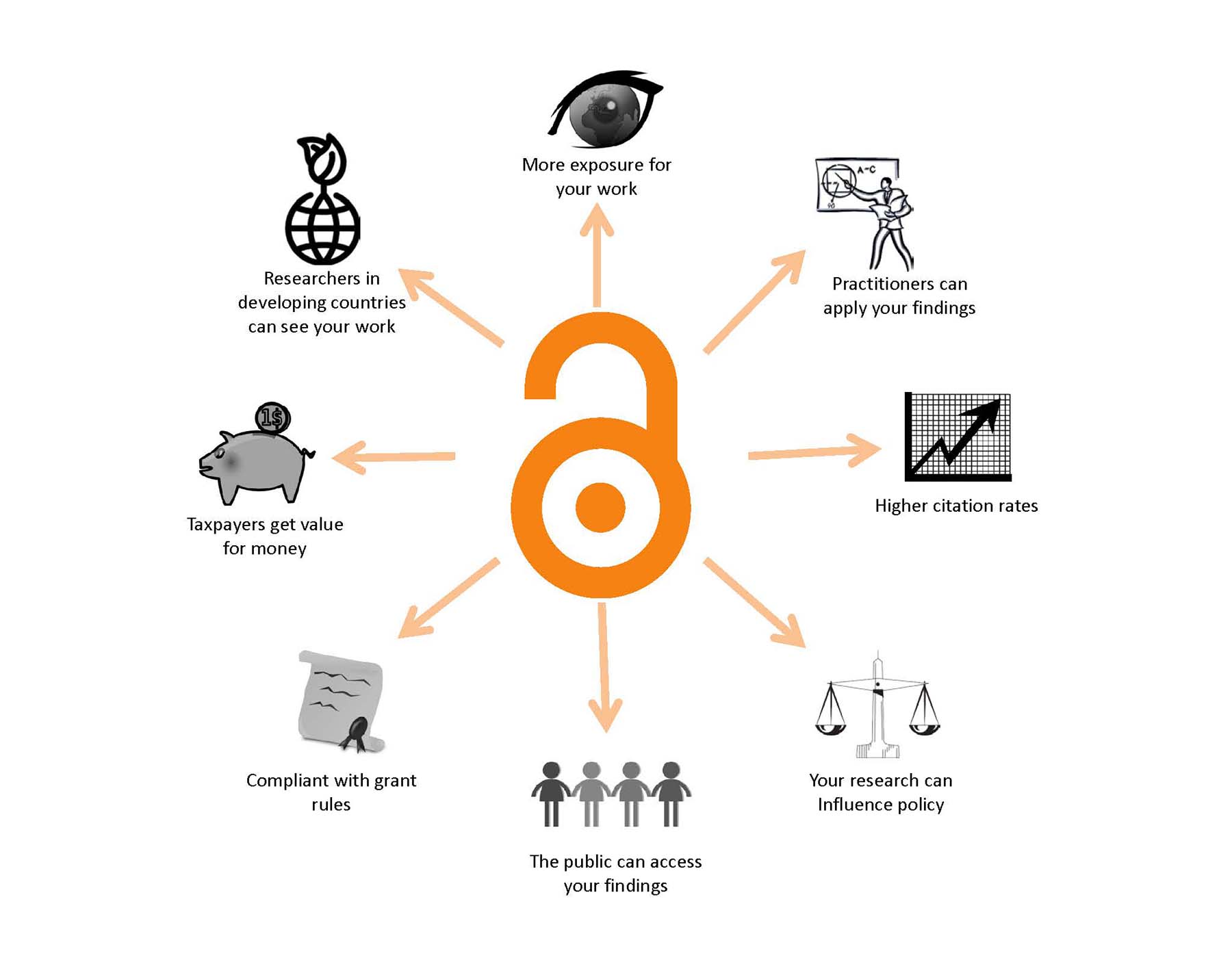Open access (OA) refers to a policy where scholarly work (articles, books, data) or other forms of digital research are made available on the web at no charge, to anyone who wants to access it with minimal copyright restrictions.
Quick Links:
Benefits of Open Access
Depending on the resources’ licensing terms, users can find, view, download, print, copy, reuse, and even modify them for any (lawful) purpose, usually without financial, legal, or other barriers. In addition to reduced barriers, open access increases the visibility and availability of the author’s work. Universities who embrace open access journals and publishers can mitigate the effects of enormous subscription fees.
When important research is made available faster and to a greater number of people, everyone benefits.

Publishing Open Access
Although open access is intended to make research available at no charge, there are still upfront costs involved in making this happen. Because this is a relatively new practice, there are still various economic models being tested to see what works best, and which are most equitable for all parties involved.
Some publishers use “Closed” or subscription-based models, which require payment for access. Those looking to offer free access to materials, typically use one of five common OA models—the most popular being “Gold” and “Green.” You can learn more about the models in the table below.
|
Image

|
Bronze. Peer reviewed articles published in subscription journals. Authors transfer copyright to the publisher. Publishers make articles freely accessible to the world based on marketing reasons. Free access can be rescinded at any time. |
|
Image

|
Hybrid. Peer reviewed articles published in subscription journals. Authors may retain copyright. Authors pay additional fee to make their article open access to the world. Other articles in the journal are accessible only through library subscriptions or individual purchases. Mix of open access and subscription. |
|
Image

|
Gold. Peer reviewed articles published in open access journals. Authors may retain copyright. Authors pay Article Processing Charges (APCs) to publishers to cover their publications costs. All articles in the journal are open access to the world through Creative Commons licenses. |
|
Image

|
Diamond. Peer reviewed articles published in open access journals. Authors may retain copyright. Authors do not pay article processing charges to publishers. Institutional funds support all publications costs. All articles in the journal are open access to the world through Creative Commons licenses. |
|
Image

|
Green. Un-refereed preprint articles or refereed post-print articles published in archives or repositories. Authors retain copyright. All manuscripts are open access to the world, usually through Creative Commons licenses. Some licensing restrictions may apply for articles submitted to subscription publishers. |
Table by Moriana Garcia, University of Rochester, CC-BY. Images modified from Pixabay (Pixabay License).
Advancing Open Access at Rochester
University of Rochester-affiliated authors who are interested in sharing their research in an open access format can work with liaison librarians at the River Campus Libraries, Miner Libraries, or Sibley Library to identify potential venues, including open access journals, book publishers, and disciplinary repositories.
Here are some services and options to consider if you are willing to open your research:
- Take advantage of the libraries’ OA agreements with academic publishers to void or greatly discount article processing charges or book processing charges. Ask your librarian about specific agreements.
- Consult Sherpa Romeo --to check on individual journal copyright and open access policies-- and Sherpa Juliet --to check on funders’ requirements for data archiving and publication-- and take advantage of green OA options for your preprint or accepted manuscript (PubMed Central, NSF PAR, OSTI, etc.).
- Submit your preprint to an open repository such as arXiv, bioRxiv, OSF Preprints, SSRN, CORE, ChemRxiv, medRxiv, etc., if authorized by your target journal/publisher. Ask your librarian for additional disciplinary options.
- Deposit your data or other documents linked to your scholarship (eg. Supplementary Information) to an open repository, such as the UR Research Repository, Dryad or Zenodo. Check re3data to explore other options or ask your librarian.
- Use the Free Your Paper service to explore options for opening up previous publications.
- Add your paper to the UR Research Repository, Rochester’s new institutional repository on Figshare. Contact the library to learn more about the submission process.
- If a publisher does not offer open access options, you are encouraged to append the University’s Authors’ Addenda to your publishing contract. If approved, the addenda gives you permission to share your work on the university’s institutional repository or your personal website.
To learn more about OA publishing, schedule a consultation with a scholarly communication specialist:
- Moriana Garcia (River Campus Libraries – River Campus)
- Ehsan Moghadam (Miner Libraries – University of Rochester Medical Center)
- Jonathan Sauceda (Sibley Library – Eastman School of Music)
Open Access Agreements
Below is a list of current library agreements at Rochester that support OA. Ask your librarian for more information or explore our guide on Open Access Support at UR.
- American Chemical Society (ACS - active)
- Annual Reviews (active)
- Association for Computing Machinery (active)
- Cambridge University Press (NERL - active)
- Cold Spring Harbor Laboratory Press (active)
- Elsevier (NERL - active)
- IOP Publishing (active)
- Microbiology Society (active)
- MIT Press (active)
- Public Library of Science (PLOS - active)
- Punctum Books (active)
- Rockefeller University Press (active)
- SCOAP3 - High Energy Physics (active)
- University of Michigan Press (active)
Subscribe to our listserv -- OpenS -- to receive information about future University Libraries' agreements with publishers and other Open Access news.


